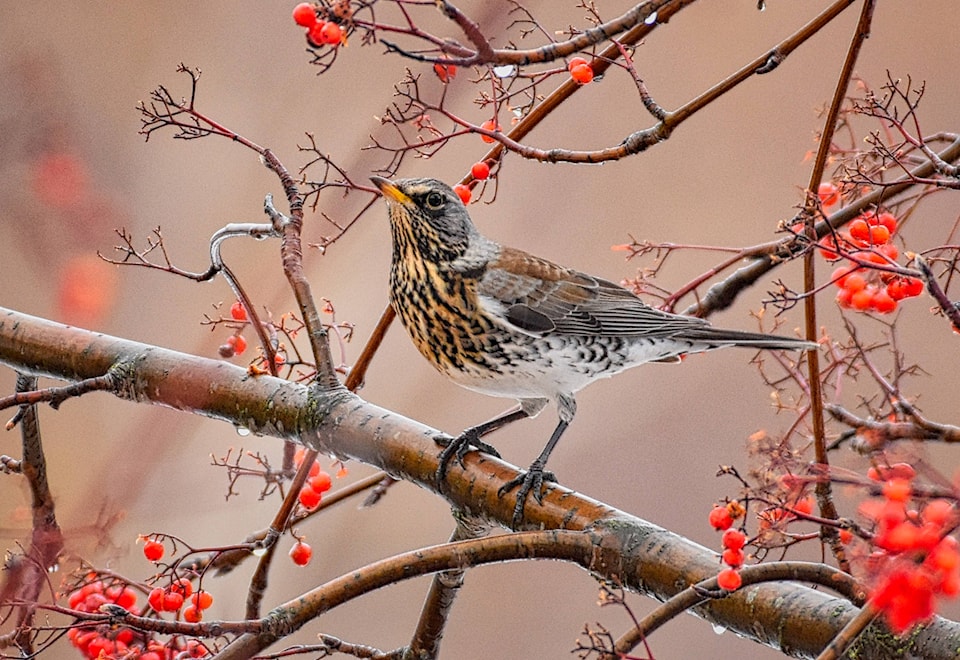Bird fanciers have been flocking to Salmon Arm following a report of a rare sighting.
The subject of the excitement is a beautiful fieldfare, a member of the thrush family and native to Northern Europe, Asia and North Africa, says avid birder Roger Beardmore who, thanks to his wife Nan, was able to see and take photos of the unusual visitor.
The Beardmores and their good friends Peter and Sharon Lawless were taking part in the annual bird count on Sunday, Dec. 16 as they have done for a number of years.
The weather was dull and drizzly as the couples headed to their usual observation grounds along Salmon River Road.
They took a right off Salmon River Road on Branchflower, hoping for their usual good luck.
“When we get to Branchflower and Crick Road, typically there’s families with bird feeders, which is often a good indication there will be birds, but there weren’t many birds,” Roger says, noting there weren’t as many feeders as in past years. “We were a bit disappointed.”
The group carried on to the corner of Kernaghan and Crick Road where they noticed robins in a mountain ash tree.
“We got out the binoculars and Nan said, ‘that one looks different,’” says Roger of the fieldfare that was among a flock of about a dozen robins. “I looked through my glasses and said, ‘yeah that is different; looks like a robin, but has a stripy chest.’”
Thinking it was perhaps a juvenile robin, the couples headed back to their vehicle, underwhelmed by what they had seen.
But something nagged at Roger, who took out his camera and went back to the tree to get a picture of the fieldfare.
He didn’t think much more of it until he downloaded the photos and did online research, where he read about an “unusual vagrant” that showed up in Victoria one year. It was a redwing thrush, which is also a European species.
“It made quite a sensation, so I Googled red wing and right beside it was a picture of a fieldfare,” he says. “And I thought that looks like this bird, a perfect match, so I sent the notice to Melissa Hafting, the provincial rare bird alert co-ordinator.”
The fieldfare’s range is referred to as “Northern Hemisphere Old World Europe, Asia and North Africa,” Roger says, pointing out the bird breeds in the northern part of that range and winters as far west as Iceland.
“If you’re going to get a vagrant, typically it would be most likely to go to eastern Canada, although they do occasionally come across from Russia to Alaska,” he adds, surmising this fieldfare arrived down the coast from Alaska and somehow made it into the Interior.
The rare sighting was recorded on an American Birding Association blog that set off a storm of excitement among birdwatchers.
Roger says visitors have come to view the fieldfare from as far away as the Lower Mainland and Seattle, and perhaps Georgia.
Despite the less-than-stellar weather, Beardmore says he and his fellow birdwatchers enjoyed the outing and recorded 30 species in their section of the bird count – eagles, swans, red-tail hawks, a northern shrike and other “usual suspects,” including pigeons, crows and ravens.
Meanwhile, Shuswap Naturalist Club member and annual Salmon Arm bird count co-ordinator Ted Hilary said Wednesday that, so far, 71 species had been accounted for.
“The highlight, of course, is the fieldfare,” Hilary says, pointing out some 22 volunteers in four teams spread out over four quadrants in a 15-mile circle around Salmon Arm, a circle that was first established in 1971.
“Starting at the Tim Hortons at the top of the hill, we go east as far as Canoe, south along Highway 97B to the junction of 97A including Grindrod and touches on the west side of Mara Lake, south on Salmon River Road to the Silver Creek store and west to Ford Road in Tappen,” he says.
The most prolific bird this year was 2,000 Canada geese, along with 1,200 starlings and “a goodly number of robins” – more than 500.
Also included in the count as of Wednesday morning were about 400 goldfinches, more than 800 pine siskins, some 500 Bohemian waxwings and, in another unusual sighting, four snow buntings were spied on the wharf in Canoe. And watchers saw one red-necked grebe, a bird that eats fish so needs open water and usually winters in Idaho, California, or the B.C. coast.
“This is a really good year for mountain ash berries so, depending on how harsh the winter is, in February and March, I think we will have lots of birds - wax wings, robins, siskins and grosbeaks,” says Hilary, who is still waiting for more bird count information, particularly from those who counted visitors to their bird feeders.
barb.brouwer@saobserver.net
Like us on and follow us on



